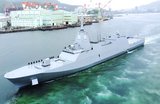FFG(X) programme fails to adhere to sustainment guidance
The USN’s FFG(X) programme could suffer the same sustainment cost overruns during the service lifetime of the type as has been found for previous classes of warships, according to a US Government Accountability Office (GAO) report.
A newly released report from the GAO has found severe weaknesses in how the USN develops ship sustainment requirements during the acquisition process, which has resulted in $130 billion of additional maintenance costs for its active fleet.
Difficulties in ship sustainment have plagued the USN in recent years as the service looks at ways to increase the size of its fleet to 355 ships
Already have an account? Log in
Want to keep reading this article?
More from Naval Warfare
-
![Future of the Canadian Patrol Submarine Project is still unclear]()
Future of the Canadian Patrol Submarine Project is still unclear
The Canadian government remains tight-lipped on the timeline and funding required for the next steps of its Canadian Submarine Patrol Project, which should offer improved capabilities for the country’s navy.
-
![Mitsubishi eyes future with Australia’s Mogami selection]()
Mitsubishi eyes future with Australia’s Mogami selection
With Australia’s selection of the Mogami-class for Project Sea 3000, Mitsubishi is investigating local production in the next decade as potential export opportunities emerge.
-
![Thales’ new Sonar 76Nano could equip UK Royal Navy on anti-submarine warfare missions]()
Thales’ new Sonar 76Nano could equip UK Royal Navy on anti-submarine warfare missions
The new sonar is designed to equip uncrewed underwater vessels, with the potential to be used by the Royal Navy for its Atlantic Bastion and Atlantic Net missions.
-
![UK to join US Navy’s Virginia-class submarine assembly effort to speed up construction]()
UK to join US Navy’s Virginia-class submarine assembly effort to speed up construction
The expansion of the Virginia-class submarine construction to UK shores could accelerate the project as US shipbuilders continue to fall short of delivery goals.























